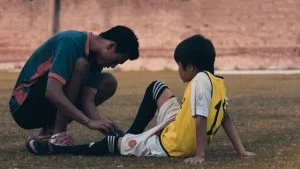Shin splints, a frequent overuse condition, result from overtraining, and muscle and bone irritability in the lower leg causes this injury. Shin splints are more common in athletes (particularly runners), members of the military, and those with osteoporosis. Stress fractures may develop from shin splints if they are not treated promptly.
If you are developing shin and calf pain but don’t know where it came from, you should consult Mid-County Physical Therapy. For starters, the following is a beginner’s guide on how to treat shin pain through recovery tricks. Get your muscles and ligaments on the right track through shin injury recovery!
What Are Shin Splints?
There are many different causes of shin splints, but they all involve the lower leg muscles and bones tugging and inflaming the area where they attach to the tibia, which causes severe pain and discomfort.
Injuries to the shin bone, muscles, and connective tissues are common among athletes. Shin splints are sometimes referred to as medial tibial stress syndrome by doctors, which is a more precise description.
Shin splints are one of the most frequent overuse injuries and may be painful. With rest and ice, the majority of individuals recover from shin splints. A stress fracture in the lower leg is possible without treatment.
How Can You Get Shin Splints?
Toxic buildup in the lower leg muscles and tissues leads to shin splints, which are common among runners and other athletes. Inflammation (swelling or irritation) and weakening of the shin bone may occur due to running and leaping.
Damage to the bone may worsen and produce excruciating pain if it is not given enough time to mend. Shin splints may occur in anybody who begins a new workout regimen or increases the intensity of their current sport or activity. This is why you should start your shin physical therapy to get better.

Easy Shin Injury Recovery Techniques
If all of the signs above tell you that you do have shin injuries, then here are the most effective means to treat your shin splint and get better over time:
Rest. To help your bones and muscles heal, take a vacation from sports and other strenuous activities. You may have to take it easy and relax for a few weeks at least. Remember, you shouldn’t overbear your muscles to stop the tearing and make the splint even worse than it already is.
Apply ice. When using a cold compress, apply it to your lower legs at least 3 or 4 times each day for a few days. Shin splints can be treated by using ice to reduce swelling and discomfort.
Use pain relievers. If you experience more pain when all the treatments don’t work, then it’s time to buy pain relievers to ease the pain. Sometimes, the recovery process tends to get in the way of reducing the pain, so pain relievers are there for that very purpose.
Stay active. Resuming your busy life should be done gradually. To prevent shin splints from reoccurring, gradually increase your physical activity. It’s better to begin your shin injury exercises again to get back in the groove.
Use supportive shoe inserts. Shoe inserts (orthotics) may help alleviate the discomfort of shin splints in those with flat feet. The bones and muscles in your legs are less stressed when you use orthotics since they support your arches.
How to Avoid Shin Splints
If you have yet to suffer from a shin injury but are concerned that they may come at some point, consider these tips to avoid shin splints:
- Shin splints can’t always be prevented, but there are techniques to lessen your chances of getting them or making them worse. Lowering your risk may be done by doing the following:
- When working out, put on a pair of sturdy sneakers. A new pair of running shoes should be purchased every few hundred miles you travel. The arches of your feet may benefit from orthotic inserts. Visit a running shoe shop and speak with a salesperson who can assist you in finding the right running shoe or orthotic for your foot type.
- Begin cautiously and gradually raise your workouts’ intensity over weeks and months. Slow and steady wins the race. Don’t increase your activities by more than 10% each week; follow the 10% rule.
- Warm up your muscles by stretching them out before you begin your workout.
- You should avoid jogging on rough, uneven, or mountainous terrain. If you often run, try including low-impact workouts (like swimming) into your fitness routine. Changing up your workout routine and taking days off are both effective strategies.
Contact Mid-County Physical Therapy for Shin Injury Recovery
Remember that pain is a good teacher as you recover from a shin injury. Reduce your exercise level if you notice soreness in your shins, and keep your distance from the suffering. Take a break and allow your muscles and bones to recover between workouts. Physical therapy for athletes especially must be taken slowly.
To ensure your recovery goes as smoothly as possible, contact Mid-County Physical Therapy to mend your muscle pain and start doing your daily activities again! We treat several related injuries, including those within the shin, and would be happy to help you recover. Give us a call today!


